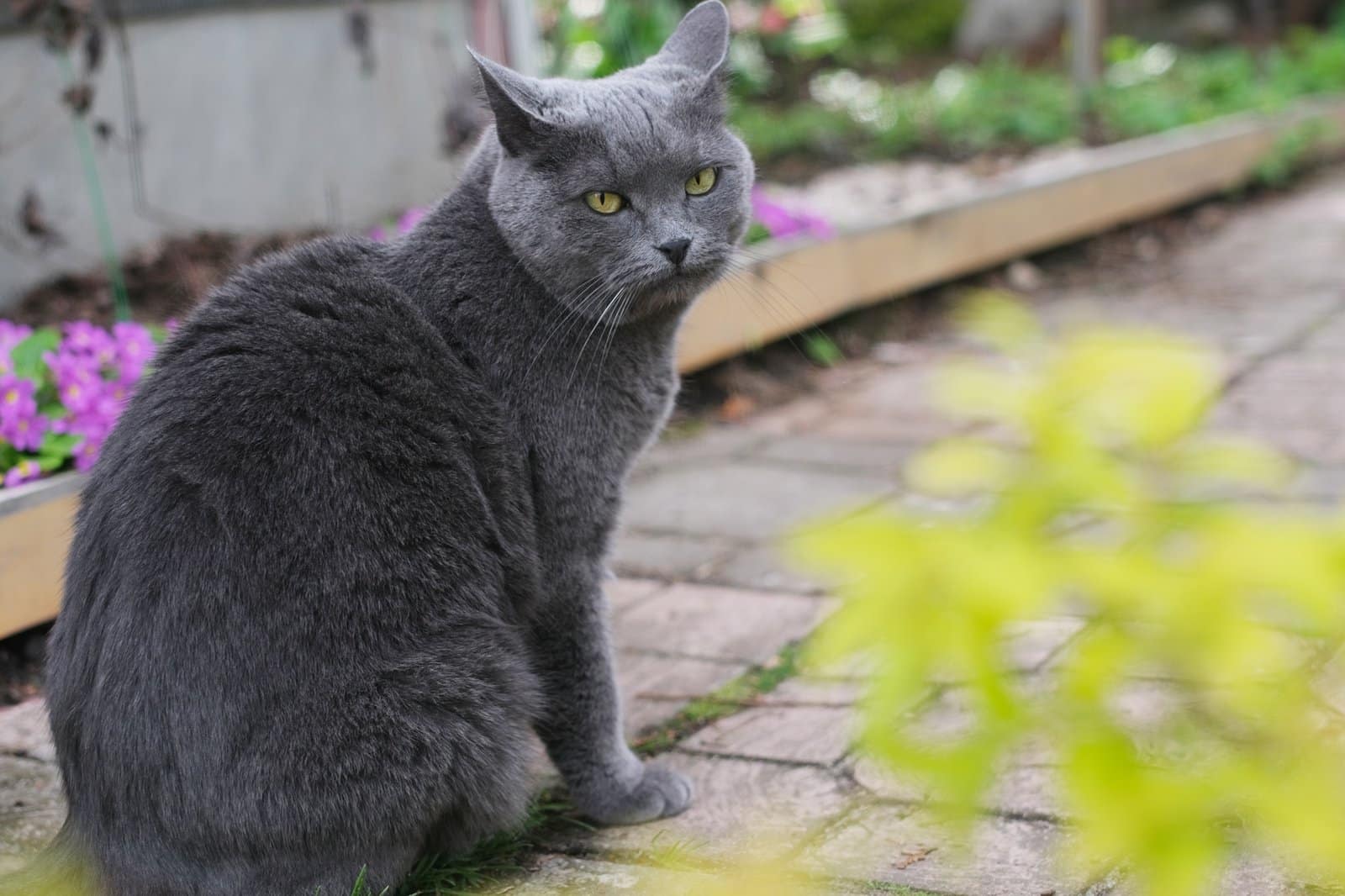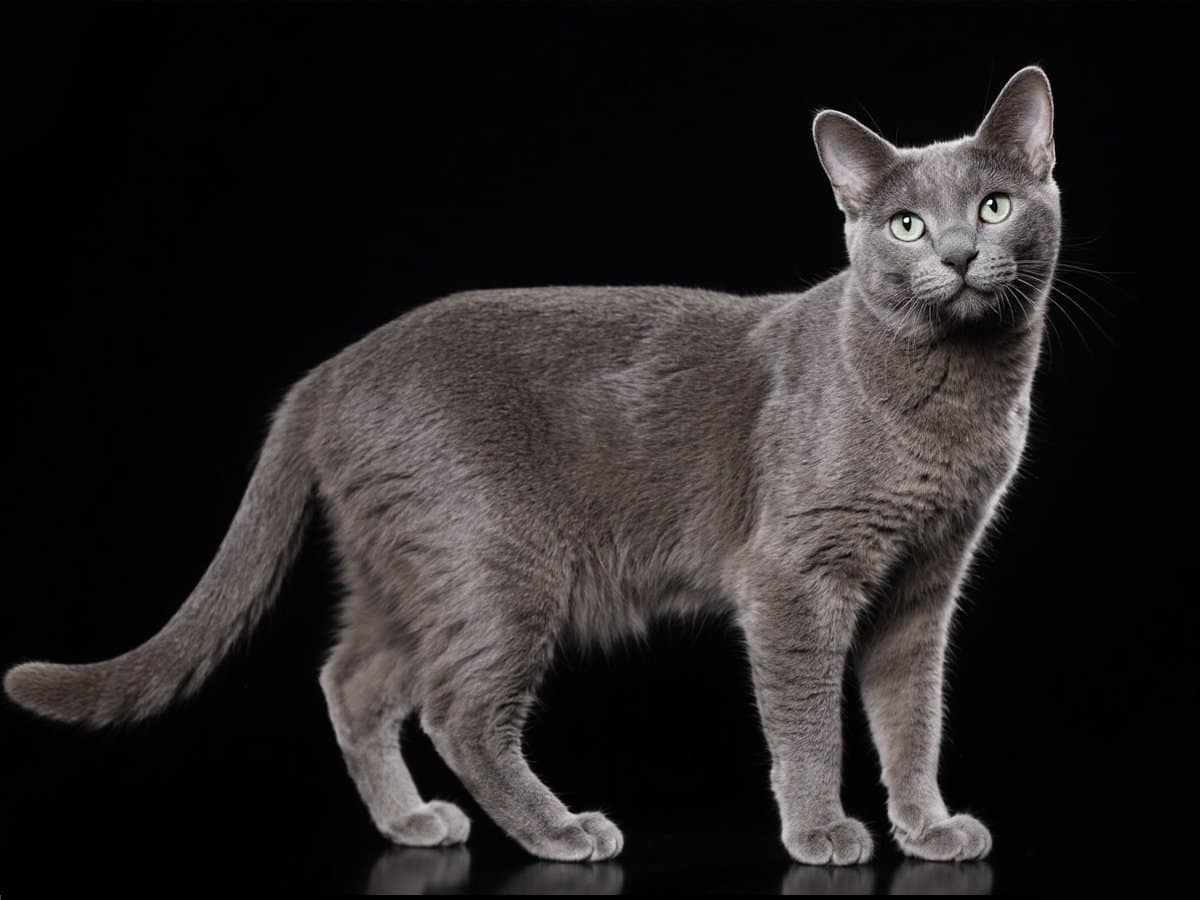Breed Overview
| Characteristic | Description |
|---|---|
| Personality | Chartreux cats are calm, gentle, and low-chaos companions. They tend to be quiet and patient, using soft chirps and body language rather than loud meows |
| Body Type | This medium-to-large breed has a sturdy, muscular build. Chartreux cats have broad shoulders, a deep chest, and a short, stocky torso with strong, short legs |
| Weight | Fully grown males typically weigh 11–16 pounds (5–7 kg), while females range around 6–11 pounds (3–5 kg) |
| Place of Origin | France |
| Lifespan | The average lifespan is around 11–15 years |
| Coat Type | They have a short, dense double coat that is slightly woolly on top with a fine, insulating undercoat |
| Coat Colors | The breed is always a solid blue-gray (often just called “blue” in cat fancier terms) |
| Shedding Level | ⭐⭐⭐☆☆ (Moderate). Chartreux shed most heavily a few times a year but otherwise require only regular grooming |
| Affection Toward Humans | ⭐⭐⭐⭐☆ (High). They form strong bonds with their families and enjoy cuddle time, though they are not overly demanding |
| Care Difficulty | ⭐⭐☆☆☆ (Easy/Low). Chartreux are considered low-maintenance; regular feeding and moderate play keep them happy |
Introduction

The Chartreux is a French cat breed known for its quiet, friendly temperament and distinctive blue-gray coat. With its broad, smiling face and bright copper eyes, the Chartreux makes a sweet, affectionate companion.
History and Origin
The Chartreux cat’s origins are partly legendary. One story says Crusaders brought woolly gray cats from Syria to France, where Carthusian (Chartreuse) monks later bred them as silent mousers. (The name Chartreux may derive from the monks’ Chartreuse liqueur or a luxurious wool called “pile de Chartreux”.)
Early accounts describe Chartreux-type cats in 17th- and 18th-century France as prized ratters and valued for their dense fur.
In the 1920s, French breeders like the Légèr sisters rediscovered the few surviving Chartreux and worked to standardize the breed.
After World War II the breed had nearly vanished, but enthusiasts cross-bred with similar breeds (such as the Russian Blue) to revive it.
Chartreux cats were first brought to the United States in 1970 and earned championship status with the Cat Fanciers’ Association in 1987.
Today the Chartreux is considered a national treasure of France and remains relatively rare outside its homeland.
Physical Characteristics
Chartreux cats have a distinctive solid blue-gray coat and round copper or gold eyes. Their heads are broad with full cheeks and a gentle, smiling expression. They are heavily muscled with a sturdy, stocky body.
Chartreux have broad shoulders, deep chests, and short legs – breeders often say they look like “potatoes on toothpicks”. Males are larger than females (around 11–16 lbs vs. 6–11 lbs).
The Chartreux’s coat is thick, plush, and slightly woolly. It has a dense undercoat for insulation and a water-repellent outer coat that protects against rain.
Gentle combing (rather than vigorous brushing) helps keep the fur healthy. Chartreux shed seasonally in clumps, but otherwise grooming needs are modest.
Behavior and Personality
Chartreux cats are known for being even-tempered and affectionate. They are typically calm and patient, often described as “low chaos” companions.
These cats are quiet by nature; they rarely meow loudly and usually communicate with soft chirps or body language.
Temperament: Chartreux cats are calm, gentle, and low-chaos pets. They enjoy a peaceful home environment and adapt well to routine.
Affection: Chartreux cats form strong bonds with their families and enjoy human company. They often choose one person to be especially close to, but they are loving and friendly with everyone in the household.
Playfulness: These cats stay playful into adulthood. They enjoy interactive toys and games like fetching or chasing feather wands that appeal to their hunting instincts. After playtime, they happily settle in for a cozy nap.
Social Compatibility: Chartreux are generally good with children and other pets. They adapt well to family life and do not demand constant attention, though they appreciate company and gentle affection.
Care Guide
Diet
Chartreux cats require a high-quality, protein-rich diet. Feed a commercial cat food that meets AAFCO standards for growth and maintenance.
Kittens should eat kitten-formula food, and adults should transition to adult cat food. Provide two balanced meals per day.
Because Chartreux can gain weight as they age, monitor portions closely and consider a weight-control or grain-free diet if needed.
Exercise
Chartreux cats are moderately active. They enjoy short bursts of play interspersed with long rest periods. Interactive play sessions (using toys, wands, or balls) keep them engaged.
Provide climbing opportunities as well, since Chartreux love jumping and surveying their surroundings from a height. These cats have strong hunting instincts and will happily chase toys or climb to high perches.
Environment & Enrichment
Chartreux thrive in a stable, predictable home. They do well indoors but also enjoy a secure outdoor enclosure if available. Vertical space is important: a tall cat tree or shelving lets them climb and feel safe.
Chartreux often follow their owners around and appreciate having people nearby. Provide puzzle toys and interactive feeders to stimulate their minds and break up routine.
Grooming
A weekly combing usually keeps a Chartreux’s coat in good condition. Use a fine-toothed comb to remove dead hairs, especially during their seasonal sheds. Brushing with a stiff brush is not needed and can damage the woolly coat. Routine care also includes regular nail trims, ear checks, and annual veterinary exams.
Mental Stimulation
Chartreux cats are intelligent and enjoy mental challenges. They respond well to training (for example, clicker training) and can learn tricks with positive reinforcement.
Make sure they have a consistent routine, with play and cuddle time. Chartreux love human interaction, so daily attention and gentle playtime will keep them happy and mentally stimulated.
Health Concerns
| Condition | Symptoms | Prevention |
|---|---|---|
| Patellar Luxation | Kneecap dislocation causing limping or a “skipping” gait | Keep your cat at a healthy weight; a lean body reduces stress on joints. In severe cases, surgery or supplements may be needed. |
| Obesity | Excess weight, lethargy. Can lead to diabetes, heart issues, arthritis | Feed a balanced diet with measured portions and ensure daily exercise. Regular weight monitoring is important. |
| Dental Disease | Bad breath, tartar buildup, red or inflamed gums | Brush the cat’s teeth regularly and provide dental chews or treats. Schedule routine dental cleanings with your veterinarian. |
Is This Breed Right for You?
| Suitable For | Not Suitable For |
|---|---|
| Families with children or other pets | Allergy sufferers (Chartreux are not hypoallergenic) |
| Owners seeking a calm, affectionate companion | Those wanting a very vocal or highly energetic cat |
| First-time cat owners (Chartreux are easygoing) | People unable to spend time interacting (Chartreux crave companionship) |
| Owners who enjoy puzzle toys, climbing structures, and regular play | Owners seeking an extremely aloof or independent pet (Chartreux prefer company) |
FAQ
Are Chartreux cats hypoallergenic?
No. Chartreux have a thick double coat and shed seasonally, releasing allergens. They are not hypoallergenic.
Are Chartreux good with children and other pets?
Yes. Chartreux cats are patient and gentle, and generally tolerate kids and other animals well.
How much grooming do Chartreux require?
Relatively little. A weekly combing is usually enough to control shedding. Extra grooming is only needed during heavy seasonal sheds.
Are Chartreux vocal or quiet?
Chartreux are very quiet cats. They rarely meow loudly and often communicate with soft chirps or body language.
Can Chartreux be trained?
Yes. Chartreux are intelligent and curious. They learn quickly with positive reinforcement and can be taught tricks through clicker training.
What is the lifespan of a Chartreux?
About 11–15 years on average, given proper care.
Bonus Facts
Chartreux cats are sometimes nicknamed the “smiling cat of France” because their full cheeks and upturned mouth give them a constant, contented expression.
The breed is also called the “French dog” or “French dog-cat”, as owners note many dog-like traits, such as following their people around and enjoying fetch-like games.
According to legend, Chartreux cats were kept by Carthusian monks in France after the Crusades. The name may come from the monks’ famous Chartreuse liqueur or from a luxury wool called “pile de Chartreux”.
The “X” in Chartreux is silent – the name is pronounced shar-TROO.
Famous French figures, including General Charles de Gaulle and writer Colette, kept Chartreux cats.
Chartreux cats remain relatively rare outside France, so finding a quality kitten often involves a wait list.
References
“One Year, A Letter”. LOOF: Livre Officiel des Origines Felines (in French). 2014. Archived from the original on 21 December 2017. Retrieved 30 October 2014.
“naming”. Archived from the original on 29 June 2022. Retrieved 14 November 2021.
(in French) DR Rousselet-Blanc (1992). Larousse (ed.). Le chat: Race et type européen (in French). p. 160. ISBN 2035174023.
(in English) Getty Center (ed.). “Magdaleine Pinceloup de la Grange, née de Parseval”. The J. Paul Getty Museum. Retrieved 30 October 2014.
Kaymak, Nuesret. All Cat Breeds of This World: All Approved Cat Breeds. Atelier Kaymak UG. ISBN 978-3-96183-036-7.
Fogle, Bruce (2001). The New Encyclopedia of the Cat. New York: DK Publishing Inc [Dorling Kindersley]. ISBN 0-7894-8021-2.
Siegal, Mordecai (1997). “2. The breeds”. In Siegal, Mordecai (ed.). The Cornell Book of Cats: A Comprehensive and Authoritative Medical Reference for Every Cat and Kitten (Second ed.). New York: Villard. ISBN 978-0-679-44953-9.
Simonnet, Jean (1990). The Chartreux Cat. Translated by Auerbach, Jerome M. Paris: Synchro Company. ISBN 978-2-9506009-0-5. (This book’s ISBNdb.com page lists “Auerbach Pub” as the publisher, but the book itself gives “Synchro Company, Paris” on an unnumbered page immediately following page 190.)
Helgren, J. Anne (2013). Encyclopedia of Cat Breeds (2nd ed.). Barron’s Educational Series. ISBN 978-0-7641-6580-1.
Buckland, Alice (2007). Cats. TAJ Books. ISBN 978-1-84406-101-3.
















